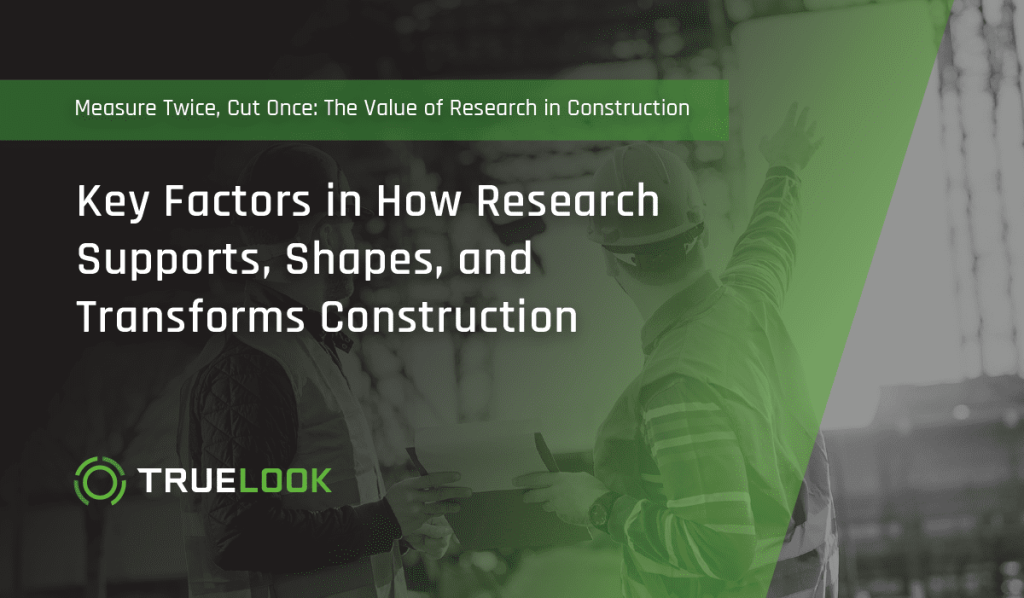
When it comes to planning and executing construction projects, research plays a critical part in ensuring safety, minimizing risk, and maximizing returns. Projects of any size require collaboration across teams. They often involve juggling data like material supply chains, labor needs, environmental factors, and current codes and standards. On a larger scale, market and industry research is crucial when it comes to making business decisions that can drive growth or affect stability.
All industries have undergone massive overhauls in the past few years, and construction has never been a stranger to industry-wide change. Understanding and analyzing the information behind widespread labor trends, supply chain status, and upcoming policies is vital for all firms, whether it affects an upcoming project or the future of their business.
In an industry that is constantly evolving to ensure best practices are in place, it is more important than ever to conduct and analyze thorough research on items like environmental changes, as well as social, and political climates. From saving on costs and utilizing available materials to preparing for economic changes and updating to the latest tech, here are key factors in how research supports, shapes, and transforms construction:
Research-based planning minimizes risk and maximizes returns
Using data-based analysis and strategies to inform decisions allows firms to opt for objective truths without the risk of relying too heavily on biased, subjective assumptions. Data-based planning might sound intimidating, but it can be as simple as looking up yearly weather and environmental patterns when scheduling work to avoid potential delays or damage. Research shows that weather delays could extend project timelines by more than 20% but using current and historical data to plan out schedules can lower risk and the overall impact of delays by more than 15%. By incorporating research into planning stages, teams can properly schedule out projects to accommodate for potential risks or road bumps. This in turn saves firms from having to make last-minute shifts, and ultimately leads to worker safety, smooth execution, and increased returns.
Understanding the market for informed decision-making
With market trends constantly changing and new technology releasing daily, it’s important to know where your firm stands in comparison to your competitors. For larger firms that are considering where to focus future business endeavors, it can be critical to know which metro areas are the upcoming hot spots for construction starts. For smaller organizations that are figuring out whether to scale or focus on stability, it’s important to first understand outside factors like where the market stands against the state of the economy or even overall labor and supply chain statuses that can affect project planning and execution.
We’re in an ever-evolving industry in a time where new technology, knowledge, and skills are popping up every day. Understanding the general state of the industry, market, and larger economy versus where your own firm stands is an effective way of figuring out where to head next.
Finding new building materials and methods to elevate your work
In the face of global climate change, firms are increasingly focusing on efficient use of materials and lowering our carbon footprints. There are new materials being developed every day, like algae-based concrete or mass timber, that are projected to pave the way for sustainable building practices. While you won’t need to invest in these today, keeping an eye out on what’s latest and greatest is a great stepping point for evolving current projects and planning future decisions.
Top construction and engineering schools like the Texas A&M School of Construction Science are also paving the way for more efficient and effective construction methods and materials. To address the safety risks of buried utility lines on jobsites, associate professor Youngjib Ham and their research team are developing a remote excavation system with a new human-robot interface. This research aims to improve on the current methods in predicting the likelihood of excavation incidents, which today are “focused on providing information to workers via a visual display,” according to Ham, “This approach can cause a cognitive ‘data overload’ problem that can reduce work performance and increase stress at work.” With their groundbreaking research and the solutions it can create, Ham and their team are potentially changing an ineffective and dangerous status quo in construction. If implemented as a future industry standard, their solution will increase worker safety and secure jobsites, while also setting up for effective, data-based decision-making in construction planning and infrastructure systems.
Doing the research doesn’t have to be tedious
Let’s face it, keeping up with research and reviewing newly released reports aren’t the most exciting ways to evolve your firm. But, it doesn’t have to feel like dreaded homework. If you’re reading our blog, you’re already doing research and empowering yourself by gaining new knowledge! At TrueLook, we keep up with the latest news and reports,updating our blogs to ensure the information is current, and readily available for our audience. By checking the latest sustainable practices or reading up on our summary of the ABC 2022 Safety Performance Report, you’re already taking the first steps to being an informed leader in construction.
Construction firms are on the lookout for solutions and methods that help elevate their practice, mitigate risks, and maximize returns. Research can take form in a multitude of ways, but including it in the planning and execution phase of your projects is an effective way in producing the best and most timely work possible.
At TrueLook, we understand the importance of research and how knowing internal and external factors can be transformative in executing projects and evolving construction firms. Read our blog to find out more industry news, or check out our case studies to see how we help evolve firms like yours!

